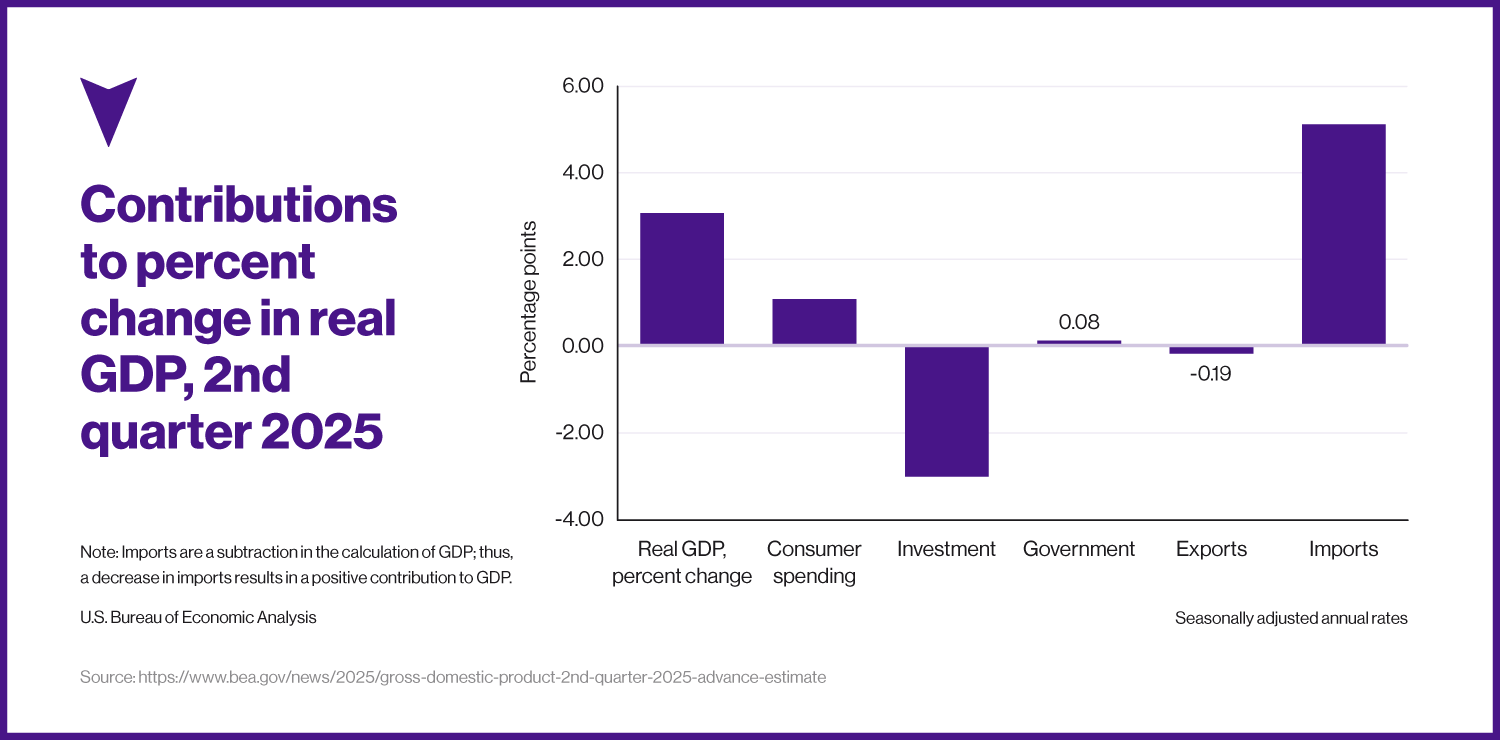GDP rose by 3% in Q2, according to data from the Bureau of Economic Analysis. But that number doesn’t tell the full story.
After Q1, we wrote that GDP “dropped” largely due to an accounting artifact. Since imports count negatively against growth, tariff frontrunning pulled on top-line figures.
Similarly, Q2 is “up” primarily because imports are down.

In this article, we’ll break down key takeaways for business owners, and share what you can do to stay a step ahead.
Key Takeaways
- Consumer spending is up only ~0.5%, and primarily in specific sectors: healthcare, food, accommodations, financial services, and insurance.
- Tariff price hikes have yet to be passed to consumers. Additionally, inflation vs wage growth lags for ~40% of Americans, dragging on consumer spending.
- Investment is down ~2.5%, but the drop is mostly contained to chemical manufacturing and wholesale trade.
- Government spending and exports were flat, despite efforts to eliminate waste and the evolving trade war.
Be Cautious of Short-Term Macroeconomic Reports
Big-picture trends are valuable signals, and we’ll get into the weeds in a moment.
But short-term reporting can obscure long-term trends, and macroeconomic data carries its own flaws.
Business owners are better off making decisions with their on-the-ground experiences and data. National averages incorporate a lot of information, and your environment may be wildly different than what’s reported on the news.
Consumer Spending Is Up, but Not Everywhere
At a glance, 3% growth looks like a return to strength. However, the true picture is more nuanced.
This category is up only ~0.5%, and primarily in specific sectors: healthcare, food, accommodations, financial services, and insurance.
If you operate here (or serve these industries indirectly), you may have more pricing power or customer demand than your peers. But if you’re outside these zones, don’t mistake headline growth for increased consumer activity in your space.
Tariffs Are Here, but Businesses Are Paying Most of the Tax
The government collected ~$30B worth of import tax revenue in July, according to the US Department of the Treasury.
However, most of those costs are being absorbed by companies.
“The evidence seems to be that tariffs are being paid by a small extent by exporters lowering their price, but companies or retailers are paying most of this for now. It’s starting to show up in consumer prices, and we know from surveys that companies have every intention of putting this through to the consumer. But they may not be able to in many cases.” – Federal Reserve Chair Jerome Powell
If your business was hit, these advanced accounting strategies may ease the pain.
- “First sale” valuation methods could lower the cost of imports directly. If an item is sold once (or many times) before arriving in the US, you may be able to value the item on an earlier sale rather than your end cost.
- If you re-export goods, you can apply for a duty drawback (and refund up to 99% of import fees and taxes).
- Using accrual accounting to defer income and accelerate expenses could preserve short-term cash flow.
- Passthrough businesses can save on income tax by converting to an S-Corp.
- You could save on payroll tax by shifting employee compensation to tax-advantaged categories.
- Businesses doing R&D in the US can take advantage of up to $500,000 in tax credits for work they’re already doing.
In the meantime, check with your vendors and ask if their margins are being impacted by rising costs, and see if (and how much) they plan to raise prices.
Investment Is Down, Should You Hold Back or Expand?
With fewer companies stocking up or expanding, you may find less competitive pressure (if you can afford to invest).
However, while private investment decreased by ~2.5%, the drop is mostly contained to the chemical and wholesale trade industries.
If you’re in a stable position, this may be the time to lock in inventory or invest in growth while competitors are on the sidelines. SBA loans are a great resource for small business owners and potentially worth looking into for the right opportunity.

Government Spending and Export Activity Are Flat, Despite Expectations
One would think, with a trade war and executive action targeted toward eliminating government outlays, these figures would have fallen. That wasn’t the case.
However, as Jerome Powell emphasized during his July 31st news conference:
“I think we’ve learned that the process will probably be slower than we expected at the beginning, and we think we have a long way to go to understand exactly where we’ll be.”
If you serve global customers or government clients, these trends may not persist. Additionally, the Big Beautiful Bill’s cuts to Medicaid spending begin taking effect in fiscal year 2026.
To stay ahead of potential trends, business owners should assess their exposure to international or government clients, diversify customer bases, and watch for future legislative or executive signals.
How Indinero Can Help
Behind every economic headline, there’s one question business owners are trying to answer. So what do I do now?
Your financials are invaluable decision-making tools, but too often, books aren’t up to date, reporting doesn’t reflect reality, and accountants are checking boxes rather than offering insights.
At indinero, we don’t just handle your taxes. We help translate data into decisions.
Reach out for a free consultation today and get the clarity and control you’ve been missing. You focus on growth, and we’ll handle the numbers.




